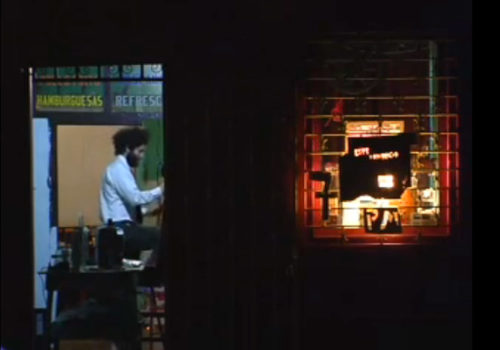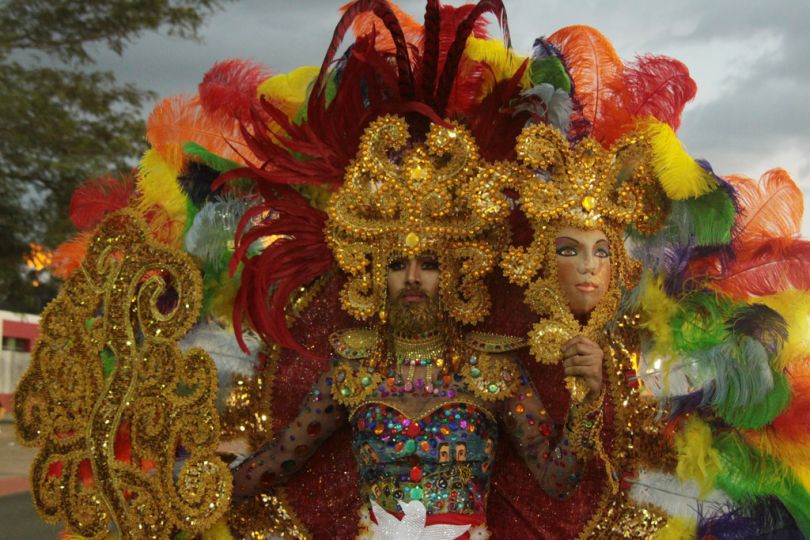Ernesto Salmeron est photographe, vidéaste, performeur et à l’origine de plusieurs initiatives visant à soutenir la production audiovisuelle au Nicaragua dans le cadre d’ateliers pédagogiques. En 2003, il lance E.V.I.L (Ejercicio Videasta Indio Ladinoameridiano), défini comme « une communauté de vidéastes qui souhaitent produire et distribuer des vidéos alternatives en marge des canaux médiatiques » et le collectif entame l’année suivante une série de workshops à l’attention des jeunes artistes locaux. Les vidéos produites à l’occasion de la première édition sont éditées, intégrées à un programme incluant d’autres vidéos d’artistes nicaraguayens et colombiens — Ernesto a étudié en Colombie à la fin des années 90 —, et projetées dans un cinéma érotique de quartier. La projection est un succès et donne lieu à d’autres workshops. En 2006, Daniel Ortega est réélu président et Ernesto Salmeron se consacre tout entier à ses projets personnels, n’ayant de cesse d’interroger le rôle de la mémoire, notamment visuelle, dans le Nicaragua d’après-guerre. Il reprend son sujet de fin d’études, Auras de la Guerre, réinterprétant archives et codes nationaux pour affirmer le propos politique de son engagement artistique. En 2007, il présente une installation intitulée Guerra colorida (Guerre en couleur), un graffiti reprenant les nouvelles couleurs du président Ortega : rose et jaune, comme un drapeau délavé du Front National de Libération Sandiniste, dont il a été la figure majeure dans les années 80 et 90. « “Réconciliation,” “progrès,” “unité” et “paix” étaient certains des termes qui ont émergé sur le fond rose de la campagne et de la présidence d’Ortega, suggérant un mouvement de rassemblement plutôt que de division – un triomphe non du marxisme ou de la révolution, mais d’un pardon accordé en toute conscience et portant sur un présent et un passé marqués par la violence et les divisions sociales », écrit Carla Macchiavello dans un essai sur le réappropriation des archives dans le travail de Salmeron publié par E-Misférica. « Dans le contexte du Nicaragua, où la révolution a acquis un statut mythique, l’écriture de l’histoire est un problème regardé de très près par l’État, qui a promu au fil des années la création de fonds culturels pour préserver le passé de la révolution. » Conscient de la complexité à l’œuvre dans la construction de la mémoire nationale et du rôle de l’art dans ce mécanisme, Ernesto Salmeron produit dans les années suivantes plusieurs documentations alternatives, utilisant tous les médiums à sa portée. Il utilisera notamment la photographie pour documenter, pendant dix ans, les foules se réunissant Plaza de la Revolucion pour célébrer la victoire des Sandinistes. Et c’est à l’image qu’il revient pour enregistrer la mémoire orale du Nicaragua a travers son projet collaboratif de recherche, Taller Imagen Tiempo. Situé a Jinotega, Niyalagua, à trois heures de route de Managua, « ce lieu fonctionnait comme base de recherche sur des sujets comme la réforme agraire, la reconversion agricole des espaces vierges et le déplacement ethnique dans un contexte de fort contraste et de débat politique violent où la mémoire constituait un vortex silencieux. », décrit-il. Le résultat de cette exploration de la région, ce sont des rencontres filmés avec des musiciens, des artistes, des fermiers, constituant en autant de vidéos une documentation historique bourrée d’expérimentations esthétiques, de vie et d’humour.
https://vimeo.com/89728092
http://hemisphericinstitute.org/hemi/en/e-misferica-72/macchiavello

















